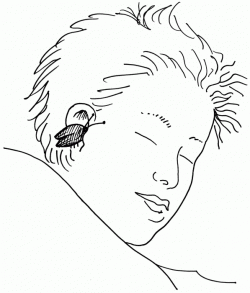A bug in your ear: Cockroaches can mean trouble
Q. Cockroaches date back 350 million years, with 4,000 known species, 95 percent living entirely apart from humans. The other 5 percent seem to be universally loathed, living in filth and breeding diseases such as E. coli, salmonella, leprosy, typhoid, dysentery, plague and hookworms. When cockroaches feed, they often regurgitate and leave behind bits of their last meal; they also deposit tiny brown droppings as they go. Even worse, many people are allergic to roaches, possibly bringing on anaphylactic shock. Yet what is perhaps the most dreaded human-to-cockroach encounter? –O. Orkin
A. The legendary ear infestation, says Amy Stewart in Wicked Bugs. Although it sounds like an urban legend, in fact cases of German cockroaches crawling into people's ears and getting stuck there have been well documented. Emergency room doctors might pour oil in the ear to drown the bugs but often have difficulty extracting them. Some doctors use a squirt of lidocaine to irritate the roach and send it running out of the ear and across the room.
Q. If someone pushes you out of a flying airplane, off the Golden Gate Bridge, or even over Niagara Falls, is there anything you can do to save your life? –D. B. Cooper
A. Surviving a free fall from a plane is extremely rare, with just 13 confirmed or plausible incidents catalogued since the 1940s, says Dan Koeppel in Popular Mechanics online. Luck plays the major role, but there are steps you can take. Adopt a horizontal "spread eagle" posture, belly down, to maximize air drag and reduce your rate of descent. Choose a favorable landing spot and adjust arms and legs to steer for it. The best landing sites are steep slopes that gradually grow gentler, letting you slide or roll after impact. Deep snow or pine trees (with horizontal branches) might break the fall enough to save your life. Land like a parachutist, feet together, knees bent. Try to protect your head. Perhaps the most surprising lesson from stories of free-fallers is that a state of relaxation (acceptance of one's fate?) is strongly correlated with survival.
Should you aim for deep water? There's no consensus on this seemingly simple question. Because water is incompressible, a hard landing can feel like concrete, so try to go in feet-first with legs tight together, arms tight against the front of your body, hands protecting your groin. Oh, and clench your butt. People have survived falls from the Golden Gate Bridge (270 feet), and one man is known to have lived through a ride over Niagara Falls (180 feet) without protective gear.
Q. When are cars actually "greener" than people? –H. Ford
A. When the cars are hybrid and the people are four men jogging to their destination rather than riding, says University of Milan physiologist Alberto Minetti, as reported by Anna Kuchment in Scientific American magazine.
Minetti measured the carbon dioxide emissions of the four men when walking, running, and biking compared with when riding in gasoline, diesel and hybrid cars; he found that the four joggers released 100 grams of carbon dioxide per kilometer compared with about 90 grams in a hybrid car. But the carbon dioxide output of four women jogging was less than if they rode because of their lower body mass.
"The lesson: Next time you and three male friends are late for the movies, don't run. Hail a hybrid taxi."
~
Send Strange questions to brothers Bill and Rich at [email protected]
